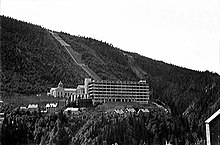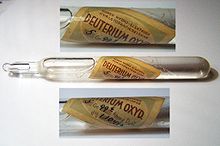Norwegian heavy water sabotage

The Norwegian heavy water sabotage consisted of several operations during the Second World War, both the Norwegian resistance and the Allies were carried out to evaluate the use of the Norwegian power plant Vemork produced heavy water for the expected development of a nuclear bomb by Nazi Germany to prevent.
prehistory
In 1933, American scientists discovered heavy water . This is water in which the isotope deuterium is enriched. It can be used in a nuclear reactor to act as a moderator to slow down the neutrons to an energy suitable for the chain reaction.
The production process of heavy water by water electrolysis is time consuming. At the time, it was only produced in significant quantities in Europe by the Norwegian power station Vemork near Rjukan ( Tinn municipality , Telemark province ) by the Norsk Hydro company. It was created in the factory as a by-product of the production of ammonia , which was used to make potassium nitrate and fertilizer .
Even before the occupation of Norway in 1940, the Germans showed interest in the factory, and IG Farben made an offer to buy the existing heavy water. They needed it for experiments in the context of the uranium project , which pursued research into nuclear fission and possibly the development of the atomic bomb . The Allies found out about the offer from the Germans, and a group of Parisian scientists led by Frédéric Joliot-Curie , who had recognized the benefits of heavy water as a moderator , asked the French armaments minister Raoul Dautry to inform the Norwegians about the military importance of heavy water and it to acquire yourself. Shortly before the occupation of Norway by the Germans, France succeeded in fetching the existing supplies of heavy water from Norway and in June 1940, during the conquest of France, brought them to Great Britain via Bordeaux . Immediately after the occupation of Norway, the Germans demanded that the production of heavy water be increased significantly.
preparation and execution
In Great Britain, the Norwegian company Linge was formed in 1941 within the Special Operations Executive (SOE) . First of all, it dropped the civil engineer Einar Skinnarland , who had worked in the power station himself but fled to Great Britain after the occupation, by parachute nearby. Skinnarland was supposed to provide the operations center with up-to-date information about the guard and possible movements of the Germans. Later another four Norwegians from the area, including Knut Haugland as a radio operator, were recruited for Operation Grouse , an advance command for the British Operation Freshman. The Grouse Group's mission was to find a runway suitable for gliders in the Hardangervidda , to prepare it, to scout the area and to receive the British and lead them to the scene.
On October 18, 1942, the Grouse group jumped parachutes over the Hardangervidda, but landed in impassable terrain, some 15 kilometers further west than planned. So she only reached her destination, the Sandvass hut, on November 10th. On November 19th, the announcement came that Freshman would land in two Airspeed Horsa that night. However, the operation turned out to be a fiasco: Due to poor visibility, the site could not be reached. After she was ordered back, the two Halifax tow planes had to disengage the gliders due to icing that had occurred in the meantime. After the crash of a Halifax and the failed emergency landing of the two gliders, a total of 41 British people were killed. Although 23 participants surgery survived the crash, but were captured, "interrogated" and in accordance with Hitler's Commando Order executed.
It was not until the end of February 1943, after Grouse's stay of more than four months in the Norwegian winter, that the alternative Operation Gunnerside began: Six other members of Linge Company were flown in to sabotage heavy water production in Vemork by blasting it. The action was successfully carried out on the night of February 27-28, 1943. All ten people involved escaped unrecognized.
However, the Germans managed to resume production, which the Allies knew by July at the latest. At first the Americans and the British considered another act of sabotage, but then decided to bomb them. On November 16, 1943, more than 160 aircraft of the 8th US Air Force flew the attack. 20 civilians were killed in Vemork and nearby Rjukan . Although the factory building was badly damaged, the heavy water production facility remained intact as seven floors, each with a concrete ceiling, were above it.
After this massive attack, the Germans wanted to move the facility to Germany as quickly as possible. On February 18, 1944, the available heavy water was loaded with the Rjukan Railway onto the railway ferry Hydro , which had to pass Lake Tinnsjå . The Norwegian resistance fighter Knut Haukelid , however, placed explosives on the night before the departure of the ferry, which sank the ferry at one of the deepest points of the lake. 14 Norwegian civilians and four accompanying Germans died in the sinking. This collateral damage was consciously accepted.
Later investigation
In the documentary Hydros hemmelighet , made in 1993 by the Norwegian television station NRK , the question of the effectiveness of the sinking of the ferry is raised. According to chemical analysis, the barrels recovered from Tinnsjå in the spring of 1993 only contained 2.5% heavy water, the rest had become "normal" water. The documentation ends with several tablets:
- “The Germans lost 500 kg of diluted heavy water when the D / F Hydro sank. It was not until two weeks later that the last heavy water was sent from Rjukan - under strict military guard. "
- “The heavy water equipment did not arrive in Germany until six months later. When they capitulated, they fell into Soviet hands and certainly helped them in their nuclear research after the war. "
- “The heavy water actions were not decisive in the race for the atomic bomb. Germany put the bombing plans on hold as early as 1942. However, the sabotages contributed to the fact that German nuclear scientists never got a uranium reactor going. "
Adaptations
Novels
- František Běhounek : Rokle u Rjukanu , from 1966 (Czech)
- John D. Drummond : But for thesis Men , published in 1962, in a later edition under the title The Heavy Water Raid published
- Hasso Grabner : Norsk Hydro is a secret , German military publisher 1966
- Andrew Gross : The Saboteur , Minotaur Books, New York 2017, ISBN 978-1-250-07951-0
- Amanda Mitchison : Mission Telemark , Walker Books 2010 (children's book)
Cinematic adaptations

The story was told in 1948 in Norway as a semi-documentary fictional film under the title Battle for Heavy Water ( Kampen om tungtvannet ).
In 1965, the story was filmed in the British movie Keyword "Heavy Water" ( The Heroes of Telemark ) by director Anthony Mann with the main actors Kirk Douglas and Richard Harris . The film is based on the books Skis Against the Atom and But for These Men .
The Norwegian television broadcaster NRK1 produced the 6-part television miniseries Saboteurs im Eis - Operation Schweres Wasser ( Kampen om tungtvannet ), which retells the story and was broadcast for the first time in Norway in 2015 and in Germany in 2018 ( Das Erste ).
Games
There are also video games that contain the sabotage as at least one mission. This includes Battlefield V from 2018.
literature
- Neal Bascomb: The Winter Fortress. The Epic Mission to Sabotage Hitler's Atomic Bomb , Houghton Mifflin Harcourt 2016, ISBN 978-0-544-94729-0 .
- Thomas Gallagher: Assault in Norway. Sabotaging the Nazi Nuclear Bomb , Harcourt Brace Jovanovich , New York 1975, ISBN 0-15-109582-5 .
- Knut Haukelid: Skis Against the Atom , originally published by William Kimber in 1954, later also by Fontana Books 1973 and North American Heritage Press 1989 ( ISBN 0-942323-07-6 ).
- Claus Helberg: The Vemork Action. A classic act of sabotage , in: Jahrbuch Den Norske Turistforening 1947, edited version of the CIA 2011
- Roland Knauer: Fight over heavy water . In: Frankfurter Allgemeine Zeitung . February 22, 2019, p. 6 . ( faz.net ).
- Dan Kurzman : Blood and Water. Sabotating Hitler's bomb , Holt, New York 1997, ISBN 0-8050-3206-1 . ( Review in the New York Times )
- Jens-Anton Poulsson: The Heavy Water Raid. The Race for the Atom Bomb 1942-1944. Orion forlag As, Norway 2009, ISBN 978-82-458-0869-8 .
Individual evidence
- ↑ David Irving: As big as a pineapple ... In: Der Spiegel . No. 23 , 1967, p. 76 f . ( online ).
- ^ Hydros hemmelighet , accessed February 6, 2015.
- ↑ Strictly speaking, this is not 2.5% D 2 O and 97.5% H 2 O, but 5% DOH in 95% H 2 O.
- ↑ The Norsk Hydro plant produced heavy water with a content of 99% D 2 O, K. Wirtz (on p. 375), Historical facts on uranium work in Germany in 1940–1945, Phys. Sheets 3 , 371–379 (1947)
- ↑ Due to leaks (barrel closures, temperature-related pressure fluctuations in the barrel, barrel corrosion, etc.), an H / D exchange with seawater is very easy in 50 years.
- ↑ Original quote: « Tyskerne laps 500 kilos fortynnet tungtvann da D / F Hydro gikk ned. Først to uker senere ble det siste tungtvannet sends fra Rjukan - under strict military evacuation. »
- ↑ Original quote: « Først et halvt år senere havnet tungtvannsapparaten in Tyskland. Ved kapitulasjonen havnet equipment on sovjetiske hender and has to be trolig hjulpet the their atomforskning etter krigen. »
- ↑ Original quote: « Tungtvannsaksjonen var ikke avgjørende i kappløpet om atomic bombs. Tyskland skrinla bombeplanene old i 1942. Men sabotasjene bidro til at tyskerne aldri fikk igang en uranreaktor. »
- ↑ Fight for heavy water. In: Lexicon of International Films . Film service , accessed February 22, 2020 .
- ↑ Kampen om tungtvannet , accessed on November 18, 2014.
- ↑ When the Nazis wanted to build the bomb January 2, 2018 on Spiegel Online, accessed January 4, 2018.




